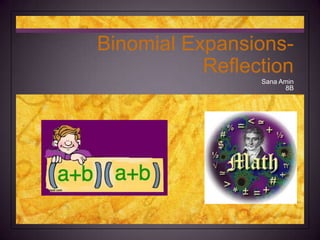
Math reflection
- 1. Binomial Expansions-Reflection Sana Amin 8B
- 2. Introduction Mathematicians have always tried to find short cuts, patterns and relationship between numbers to make it easier to calculate or solve equations. Multiplication for example is used often in day to day life, but it not always an easy task. So mathematicians have been able to develop formulas to easily solve some of the multiplication problems. One such method is known as binomial expansion. This method as a general rule applies when you are multiplying a number with itself one ore more times. This method allows a complex number which is hard to multiply by itself to be broken down into two easier numbers to multiply, add and subtract. For example it is hard to do 795 * 795 but it is much easier to do 800 * 800, 5 * 5 and 800 * 5.
- 3. Benefits Imagine an engineer about 100 years ago, who didn’t have calculator how would he or she calculate an area of a square. For finding area of a square you have to multiply length of one side by itself. This may not be an easy task all the time, but can be made simpler by using formulas. If you are multiplying two numbers that are equal and the difference between this number and the next number which is easy to square is small , the method will then be useful. For example instead of multiplying the 998 the long multiplication way ( 998 * 998 ) it is easier and usually more convenient to solve (1000-2) ². As you can see it is easier to find the square of 1000 as well as of that of 2. It is also easier to multiply 2 and 1000. That’s why this method is more useful as shown below. ( a+b) ( a+b) = a² + ab + ba + b² = a² + 2ab + b² (998) ² = (1000 – 2) ² = 1000000 - 4000 + 4
- 4. Limitations While the expansion method may be appealing because it helps solve complicated multiplications easily, it can be inefficient in some cases. You may have to think twice before using it in those cases. This method is cumbersome when the difference between the number and the closest number which is easy to square is difficult to square. For example 538 *538 is difficult to be solved by this method. If we used this method to solve 538 * 538 the the problem would go as follows :- ( 538 * 538) = ( 500+38 ) (500+38). As you can see it still involves multiplying 38 by itself, which is not as easy as say multiply numbers less than 20.
- 5. Continued… Similarly this method is also difficult to use if it involves decimal numbers. Some decimal numbers that extend two or more places can be difficult to be solved by this method. For example 0.363 * 0.363 is difficult to solve by this method.
- 6. Conclusion The expansion method works well when you are multiplying a number by itself however many times. However, long multiplications are sometimes more efficient. The long multiplication is more useful when multiplying small numbers. For example if you want to multiply 9 by itself it would be more efficient to use long multiplication way = 9*9 or 9² than doing it the expansion way ( 8+1 ) ( 8+1 ) which would be more complicated and in this case unnecessary. Similarly 0.1 * 0.1 is easier done by multiplication method. If the numbers being multiplied are not equal than this method can not be used.
- 7. The End